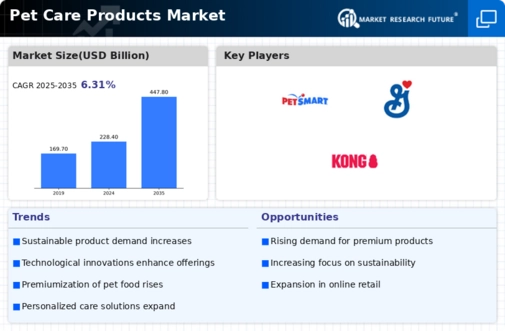Top Industry Leaders in the Pet Care Market

The Pet Care Products Market: A Tail-Wagging Maze of Competition
The pet care products market is a booming billion-dollar industry, fueled by the ever-growing love for our furry (and sometimes feathered) companions. With a projected market value of USD 325.79 Billion, it's no surprise that the competition is fierce and constantly evolving. Let's dive into the intricate landscape of this market, exploring the key players, their strategies, and the factors that determine who reigns supreme in the hearts (and wallets) of pet parents.
The Titans of Treats and Toys: Key Players in the Arena
Strategies for Scratching the Top of the Pole: How Players Differentiate ThemselvesIn a market saturated with kibble and catnip mice, companies are adopting diverse strategies to stand out. Premiumization is a key trend, with brands like Blue Buffalo and Honest Kitchen offering natural, organic, and grain-free products catering to health-conscious pet owners. Personalized nutrition is another emerging trend, with companies like Freshpet and Nom Nom taking DNA samples to create custom meal plans for individual pets. Sustainability is also gaining traction, with brands like Chewy and The Honest Kitchen offering eco-friendly packaging and sourcing ingredients responsibly.
Beyond the Usual Suspects: New and Emerging Players in the Pack
The pet care landscape is constantly welcoming new entrants, shaking up the established order. Startups like Ollie and Spot by Petco offer subscription-based fresh food delivery, while companies like BarkBox and Chewy provide curated subscription boxes for pet toys and treats. These innovative approaches are attracting younger, tech-savvy pet owners and disrupting traditional distribution channels.
News From the Kennel: Industry Insights and Investment Trends
The pet care market is constantly in the news, with acquisitions, mergers, and new product launches keeping things exciting. The recent acquisition of Chewy by PetSmart for $3.35 billion highlights the consolidation happening in the online pet retail space. Meanwhile, investments in pet tech startups like Pawsome and Wag! are fueling the development of smart feeders, dog walkers on demand, and pet-monitoring cameras.
Market Share: A Game of Paws and Profits
Analyzing market share in the pet care products market is complex, with factors like product category, distribution channel, and geographical location playing a crucial role. Traditional metrics like sales volume and revenue still hold importance, but brand loyalty, customer satisfaction, and online presence are increasingly influencing market share. Understanding these nuances is vital for companies to tailor their strategies and capture a bigger slice of the pie.
The Future of Furry Friends: A Competitive Outlook
The pet care products market is expected to continue its upward trajectory, driven by factors like rising pet ownership, increasing disposable incomes, and growing awareness of pet health and wellness. However, the competition will remain fierce, with established players facing increasing pressure from niche-focused brands, innovative startups, and the ever-evolving demands of pet parents. To stay ahead of the curve, companies will need to embrace agility, prioritize innovation, and build strong relationships with their furry customers.
the competitive landscape of the pet care products market is a dynamic and exciting one, filled with established giants, innovative upstarts, and a constant stream of new trends and technologies. Understanding the key players, their strategies, and the factors that influence market share is crucial for navigating this tail-wagging maze and ensuring long-term success in the ever-evolving world of pet care.
Company Update:
Giants like Mars Petcare (owner of Pedigree, Royal Canin, and Iams), Nestlé Purina (maker of Purina and Fancy Feast), and Hill's Pet Nutrition (veterinarian-recommended diets) dominate the market with their established brands and extensive distribution networks. They leverage their economies of scale to offer competitive prices and cater to a broad range of pet needs. However, their dominance is challenged by a rising tide of smaller, niche-focused players.

